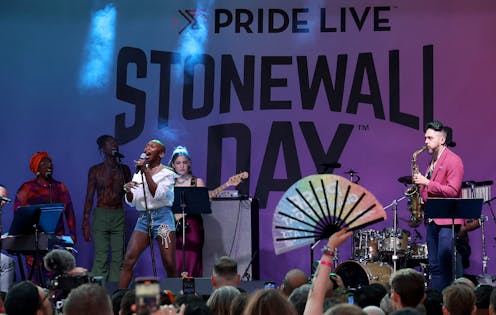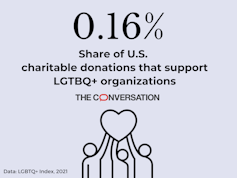Only 0.16% of all US charitable giving supports LGBTQ+ groups despite recent increases
The sliver of charitable dollars funding LGBTQ+ organizations rose in inflation-adjusted terms to $823 million in 2021 from $387 million in 2012.


In an era marked by both significant advances and setbacks for LGBTQ+ people, charitable giving to LGBTQ+ organizations more than doubled in a recent 10-year period.
Despite that swift growth, those donations still amount to only 0.16% of total U.S. charitable contributions, according to the latest edition of the LGBTQ+ Index, developed by the Indiana University Lilly Family School of Philanthropy’s Equitable Giving Lab. Put another way, less than US$1 out of every $500 donated in 2021 – the most recent year for which data is available – went to support LGBTQ+ organizations.
We are among the researchers who produce this index by analyzing data the Internal Revenue Service collects on nonprofits.
The sliver of charitable dollars funding LGBTQ+ organizations rose in inflation-adjusted terms to $823 million in 2021 from $387 million in 2012. The pace of this growth was particularly fast in 2020 and 2021, with a 35% increase over just two years.
Gifts aren’t evenly distributed
The share of overall charitable giving allocated to LGBTQ+ organizations also expanded: It grew to 0.16% in 2021 from 0.10% in 2012, continuing to lag far behind funding for other kinds of causes.
For example, the charitable donations Johns Hopkins University and World Vision received in 2021 exceeded the total of all gifts to LGBTQ+ organizations.
Giving to women’s and girls’ organizations in 2021 comprised 1.9% of total charitable giving – while still a relatively small portion of all charitable donations, this is more than 12 times the amount of money donors provided LGBTQ+ organizations in the same year.
In contrast, social service nonprofits, such as food banks and homeless shelters, received more than $90 billion in philanthropic support in 2021 – more than 100 times as much as donors gave LGBTQ+ nonprofits.
The LGBTQ+ Index also highlights shifts in how donations are distributed among different kinds of groups in this category.
Civil rights organizations, the largest category, received more than half of all giving to LGBTQ+ organizations in 2021.
Several other areas, such as youth services, community centers and transgender-focused groups, have seen significant growth in recent years. Donations to transgender-focused organizations, for example, increased by 629% from 2012 to 2021.
However, this didn’t occur across the board. Funding for organizations addressing HIV/AIDS in the LGBTQ+ community inched up by only 7% over the 10 years, resulting in a decline as a share of overall LGBTQ+ giving.
Assets are also rising
These findings underscore both the progress LGBTQ+ communities have made and the persistent challenges they face.
While heightened awareness of challenges facing the LGBTQ+ community, such as youth mental health and anti-transgender legislative efforts, have helped drive increased giving, the total funding available to LGBTQ+ nonprofits remains limited.
Smaller organizations, in particular, face significant barriers to growth, such as a lack of funding with no strings attached and a limited capacity to expand their operations.
Separately, we found that the total value of assets held by these groups in rainy-day funds or endowments has grown by 257% over the past decade. That growth in assets signals that donors have greater confidence in LGBTQ+ groups and that the organizations are becoming more established and professional. It also signals that there’s potential for further growth.
Jacqueline Ackerman is employed by the Indiana University Lilly Family School of Philanthropy, which has received funding from Google.org for this research.
Jon Bergdoll is employed by the Indiana University Lilly Family School of Philanthropy, which has received funding from Google.org for this research.
Read These Next
What’s at stake in Trump’s executive order aiming to curb state-level AI regulation
In the absence of comprehensive federal AI regulation, states have stepped in. The Trump administration,…
Data centers need electricity fast, but utilities need years to build power plants – who should pay?
How many data centers will be built – and how much electricity they’ll need – is uncertain. Being…
Sleep problems and depression can be a vicious cycle, especially during pregnancy − here’s why it’s
Inadequate sleep can have negative downstream effects on everyday cognitive functioning and mental health,…





